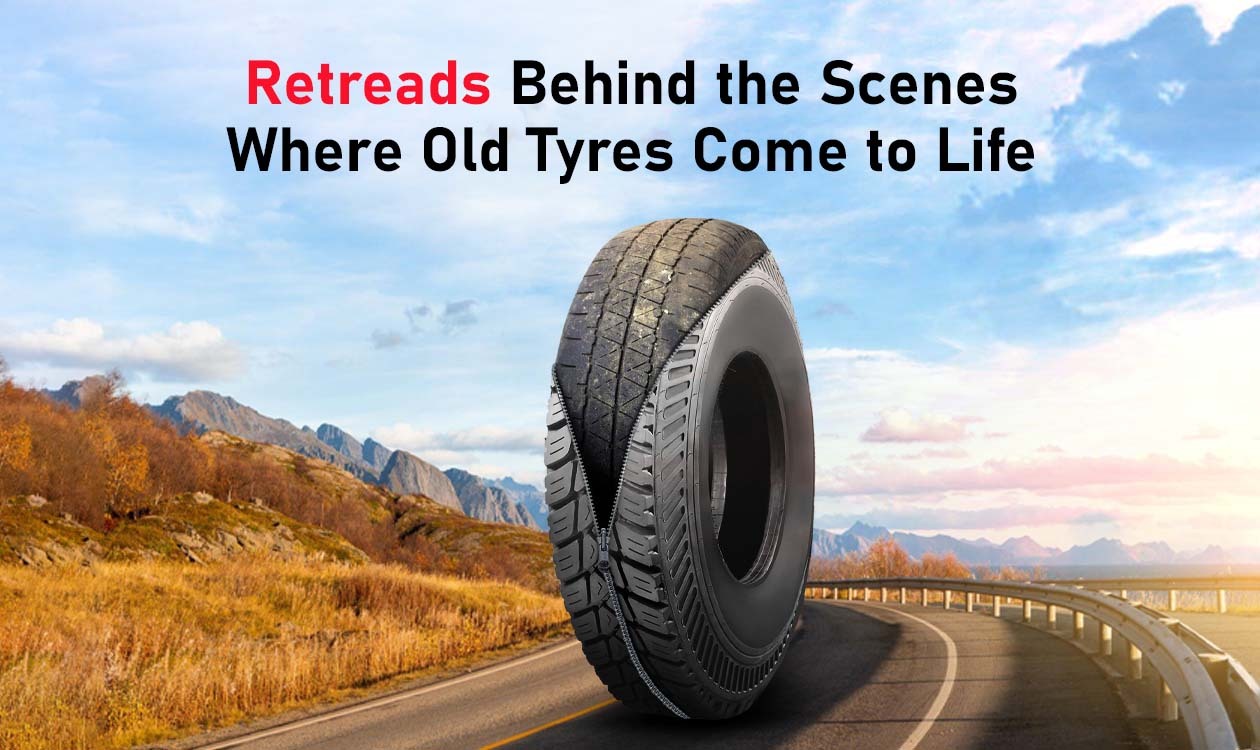Choose casings that are removed at the Tread Wear Indicator (TWI) and have no severe damage.

What Is Retreading?
Retreading involves rejuvenating old tyres, and extending their lifespan. This process begins by removing the worn-out tyre casing with good structural integrity. This casing undergoes a comprehensive renewal, receiving fresh tread and sidewall rubber. Next, the revitalized tyre proceeds to a curing process where the new rubber bonds with the original casing, forming a brand-new tread pattern.
The tyre manufacturing industry worldwide has witnessed remarkable advancements over the years. Premium technologies are employed to create high-quality tyres, ensuring top-notch performance not only in their initial life but also through multiple retreading cycles. Consequently, the retreaded tyre sector has thrived, benefiting from robust tyre casings, improved re-manufacturing techniques, and superior rubber compounds.
Retreading becomes necessary when a tyre's tread depth diminishes to 2-3 mm, after re-grooving, or in case of punctures requiring repair. To assess whether a tyre is suitable for retreading, it is essential to consult a skilled technician who will conduct a thorough inspection. If the tyre passes muster, it can undergo the retreading process.
Advantages of Retreading
Versatile Usage
Retreads are now widely used in various vehicles, including taxis, trucks, school buses, and military vehicles.
Environmental Friendliness
Retreading is eco-friendly, saving landfill space, reducing carbon emissions, and conserving oil resources used in new tyre production.
Cost-Effective
Retreaded tyres are significantly more budget-friendly than new ones, offering savings of up to 50% per retread.
Road Safety
Contrary to misconceptions, retreaded tyres are not responsible for rubber debris on roads; this issue is often caused by factors like road hazards, tyre failures, and overloading.
Extended tyre Life
Retreading allows tyres to perform as effectively as new ones, extending their lifespan by reusing casings and adding new treads, typically up to two or three times based on tyre condition.
Process of Retreading
FIRST INSPECTION 
The initial step in the retreading process is to inspect the tyre, ensuring it meets our stringent quality standards. To identify punctures, ruptured cords, separations, or any other minor flaws, a visual and tactile examination of the casing is carried out during the inspection. Casing that fails the inspection is deemed unacceptable and cannot undergo retreading.
BUFFING AND CEMENTING 
The casing crown becomes a uniform surface during the buffing process, allowing the installation of the new tread on top of the casing using high-speed rotating rasps and brushes. The buffing process removes the remaining tread and sidewall rubber from the casing to the exact precise dimensions. While curing, it aids in precise adhesion of fresh tread to tyre.
High-powered fans are used to extract the granular residue created during the buffing process, which is then gathered in sizeable hoppers in preparation for recycling. After buffing, the area is covered with rubber solvent (universal spray cement), which lessens surface oxidation (surface oxidation reduces the surface tack of the casing, which results in less bonding of the tread and casing, resulting in early tyre failure).
Repairing and Skiving 
It is crucial to fix cuts and damages, because failing to do so could result in the tyre’s full failure to cure after buffing. Skiving is a process of removing damaged or loose parts from the casing (injuries or damages caused by inadequate maintenance or abuse of the tyre on the road).
In order to rebuild the casings intrinsic strength, the cuts and damages or fixed by adding repair gum to the damaged skived area where the holes are huge or a specialised patch of that location from where the piles or damaged.
Construction 
The final and crucial step in tyre construction involves the careful selection of pre-cured tread rubber belts from Surya Rubber Industries, tailored to match tyre sizes and appropriate tread patterns. A thin sheet of bondigum is meticulously wrapped around the buffed tyre casing to serve as a bonding agent, firmly connecting the buffed area and tread. Once wrapped, the tread is precisely positioned on the end of the bondigum-coated buffed tyre, ensuring an airtight seal between the tread and bondigum. Lastly, the tread undergoes a meticulous rolling process with the aid of a roller, ensuring a flawless finish.
Curing 
During curing process, the "built" tire is enveloped in a flexible rubber casing, ensuring uniform pressure at all tread points and achieving a strong bond between the tread and casing. Moreover, two wicking pads are placed between the rubber envelope and the tire to facilitate the release of any trapped moisture.
The finalized tire undergoes the automated heat chamber of a curing press, where it is inflated to a maximum of 300psi and heated for up to 95 minutes at a temperature of 155 °C.
By properly vulcanizing the fresh rubber and curing the bondigum, the tire is produced with the same tread pattern and depth as specified, thanks to the optimal combination of heat, time, and pressure. The methodology employed for creating new tires remains consistent with this process.
Final Inspection 
The cured tires undergo a comprehensive final inspection procedure upon deflation, removal, cooling, and trimming. This process includes three meticulous inspections:
- A thorough visual and tactile inspection is conducted by a trained eye to detect any flaws in the tread pattern or sidewall.
- In the second inspection, the tire is subject to an inflation test where it is rapidly inflated to 150 psi. This test exhibits any structural flaws or weaknesses.
- The third inspection involves a visual examination of the tread's adhesion to the casing before the retreaded tire is carefully polished.
The tire is now ready for use and performs on par with a brand-new one.
More than Products: A Promise of Service
We're not just a company, we're a connection. Our dealer network is a thread weaving us closer to you. Your needs power our sails, and we mold our service to fit your demands like a glove.








